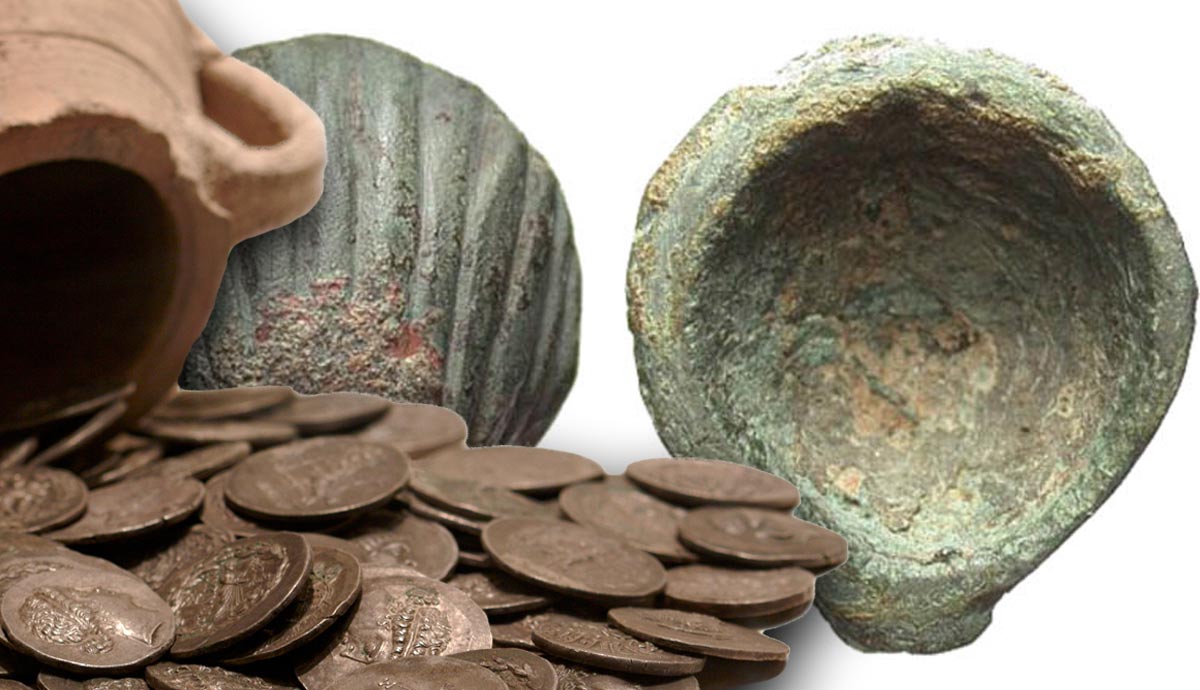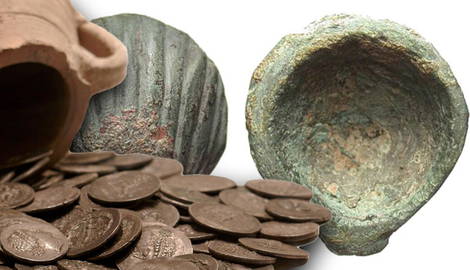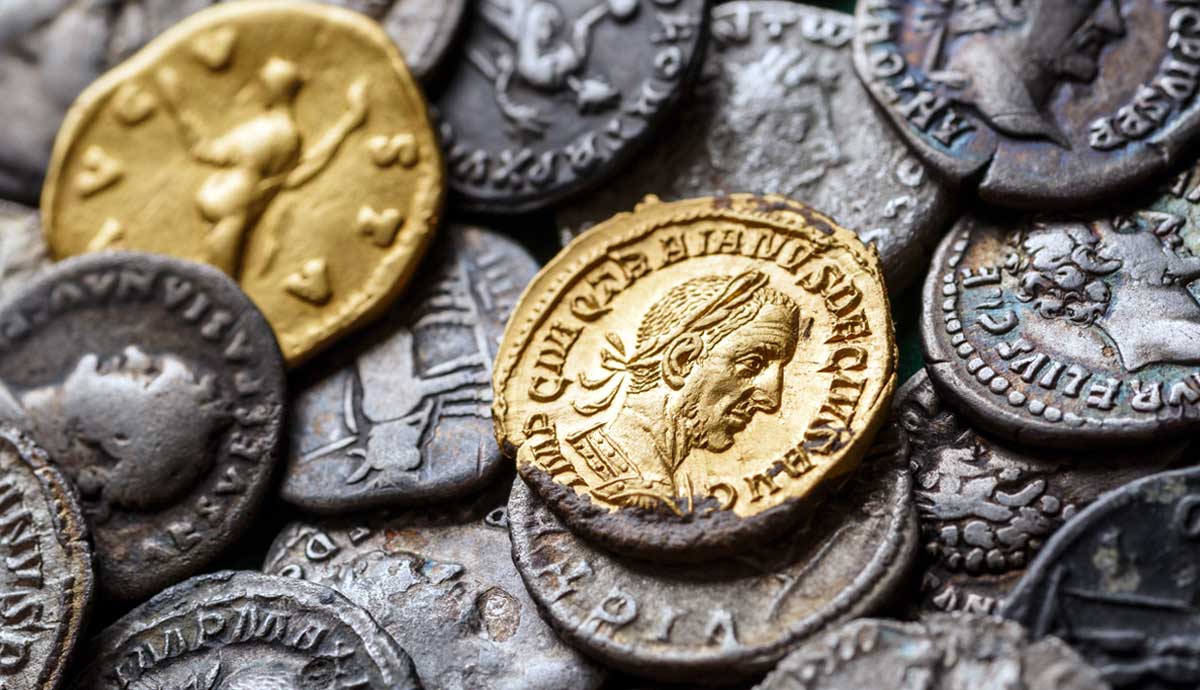
For centuries, the Roman coinage was based on a silver standard. It was dominated by the silver denarius, which was first introduced in 211 BCE. However, before the Punic Wars and the capture of Iberia (Spain), Romans did not have access to large amounts of silver. Because of that, early forms of Roman currency were based on a bronze standard for a long time. These included irregular lumps of bronze (aes rude) and stamped bronze ingots (aes signtum). For centuries these were the only types of proto-currency used in Rome and Central Italy. They were probably used as a bullion exchanged by weight. In the early 3rd century BCE, Romans started to produce their first coinage.
Earliest Proto-Currency

The earliest forms of trade in human society were based on systems of barter. Livestock and other goods were used as mediums of exchange. The same can probably be said for ancient peoples of Central Italy, including the Romans. Although coins were first introduced in Italy during the 5th century BCE by the Greeks, Romans did not develop a coin-based economy until much later.
Pliny the Elder tells us in his Naturalis Historia that the Latin word for money itself (pecunia) comes from the word for sheep or cattle (pecus). According to Dionysius of Halicarnassus, fines were paid in livestock, with the maximum fines being two oxen and 30 sheep. Alongside cattle, metal was also used as a medium of exchange.
The Romans did not have access to large amounts of precious metals prior to the Punic Wars. However, copper and tin were readily available, which made bronze the metal of choice for bartering. This led to the creation of the first proto-currency used by the ancient Romans—unworked lumps of bronze known as aes rude or aes infectum.

When this primitive form of currency was first introduced is not known. The earliest specimens date to the 8th century BCE. Hoards of aes rude were found all over Italy. Aes rude came in different shapes and sizes, and they greatly varied in weight. They did not bear any sort of markings or stamps as they were probably manufactured privately. If we are to believe ancient Roman writers, bronze was not recognized as a form of payment by the state until the 5th century BCE.
In 454 BCE, consuls Aulus Aternius Varus and Spurius Tarpeius Montanus introduced a law called the lex Aternia Tarpeia. The law was promulgated in order to regulate the value of livestock that was used for paying fines. According to Cornelius Gellius, a sheep was valued at 10 asses (or 10 librae/Roman pounds of bronze) and oxen at 100 asses. In 430 BCE, payment of fines in bronze was made mandatory, promulgated by the law called lex Papiria Iulia.
Further Developments

Bronze could be used as a medium of exchange in any shape and form. This eventually led to the appearance of what numismatists call aes formatum. That term designates many different types of cast bronze bullion that were used alongside aes rude.
Unlike aes rude, aes formatum had predetermined shapes and sizes based on their molds. They were cast without any inscriptions or images. The most common types include round cakes, shells, bricks, bars, and ingots. As was the case with aes rude, they were valued by their weight. Because of that, they were sometimes cut into pieces to make small change.
Hoards of aes formatum are found all over mainland Italy but also in Sardinia, Croatia, Slovenia, and as far away as North Africa, Spain, and Britain. These archaeological finds clearly indicate that aes formatum was used as a trade commodity, not only as a mining product.

The next phase in the development of early Roman currency was the introduction of stamped bronze currency bars known as aes signatum. It is unclear when they first appeared. Ancient Roman authors ascribed them to the legendary Roman king Servius Tullius (578-535 BCE). This is very unlikely, and some later date is much more probable, probably sometime during the 5th century BCE. It is possible that the introduction of aes signatum was in correlation with the laws of 454 and 430 BCE, which recognized bronze as an official form of payment.
Similar currency bars circulated in Central Italy even before that, such as ramo secco bars, which bore the image of a dried branch (hence the name). Most of these date to around the 6th-4th century BCE. They greatly varied in size and weight and were often cut into smaller pieces, similar to aes formatum. Roman currency bars, on the other hand, were issued by the state and had a much more standardized weight of around 1,625 grams, or five Roman pounds.
Aes signatum was in use alongside aes rude and aes formatum because they all appear together in hoards. Most aes signatum date to the first half of the 3rd century BCE, which means that it remained in use after the introduction of coinage.

Aside from being an important step in the development of Roman currency, aes signatum bore some of the earliest propaganda messages and depictions. Many depicted military and naval themes (swords, shields, spears, and anchors), while others depicted various animals (bulls, eagles, dolphins…). Most aes signatum did not bear any inscriptions. Only one type that survived to this day bears an inscription on the reverse that reads ROMANOM.
Some depictions can be connected to certain aspects of Roman religion. For example, one type depicts two chickens facing each other, most likely the sacred chickens of Rome. Before Romans set off to battle, special priests called augurs would consult those sacred chickens for good or bad omens. Chickens would be offered food, and if they would eat it, it was considered a good omen and vice versa.

Some depictions on aes signatum can even be connected to certain historical events. For example, one type depicts an elephant and a hog, which likely alludes to the story of the Battle of Asculum (279 BCE), when the elephants of Pyrrhus were scared off by the grunting hogs.
First Roman Coinage

The first coins used by the Romans were not actually produced in the city of Rome. They were produced for Rome by the city of Neapolis, which the Romans captured in 327 BCE. The coins themselves were Greek-styled bronze coins and a small quantity was struck during the late 4th century BCE, possibly around or after the construction of the Appian Way in c. 312-308 BCE. They featured a depiction of Apollo or Minerva on the obverse and the inscription that read ΡΩΜΑΙΩΝ or ROMANO below the man-faced bull on the reverse.
The Romans began to properly issue coins during the Pyrrhic War (280–275 BCE) when they introduced a system based on a bronze standard. Numismatists call these coins aes grave (heavy bronze). These coins were cast, unlike later coins of a denarius system which were minted. The base coin of this system was an as which was equal to one libra (Roman pound, c. 323 grams). The smallest denomination was called uncia which had a value of 1/12 of an as. Essentially, the first Roman monetary system was based on a bronze standard of 1 as = 1 libra = 12 unciae. Various bigger and smaller denominations (multiples and fractions) were issued throughout the 3rd century BCE.

Besides bronze aes grave, Greek-style silver coins were also produced after 280 BCE. Their purpose was perhaps to facilitate trade with the Greek cities in Southern Italy or for payment of troops during the Pyrrhic War. The first of these silver denominations was a didrachm. Initially, it was issued by different southern Italian cities. Their distinctive features included the head of Mars with a Corinthian helmet on the obverse and an inscription that read ROMANO below the image of a horse head on the reverse.
In Rome, the first didrachm was struck around 269 BCE. Other silver denominations were also struck, such as quadrigatus, litrae, and double-litrae. The quadrigatus was introduced after c. 235 BCE, and it featured an image of Victory riding a quadriga (four-horse chariot) on the reverse, hence the name.

During the course of the 3rd century, the “aes grave system” faced serious challenges, especially during the Second Punic War (218–201 BCE). Silver coins were rarely struck after c. 225 BCE, while bronze coins were rapidly debased. Methods of production also changed. Aes grave was now struck rather than cast. Around 217 BCE, aes grave was reduced to a semi-liberal standard, which meant that 1 as was equal to 5 unciae. During the following years, the Roman monetary system completely collapsed, and the weight of an as rapidly decreased, dropping to below 40 grams (1-1.5 unciae) around 211 BCE. In that year, the Romans introduced a new monetary system.
Although the as and its fractions continued to be struck, the new system was based on a new silver coin—the denarius. It had a value of 10 asses and a weight of c. 4.5 grams. A group of three magistrates called tresviri monetales were established to oversee the minting of coins. Denarius remained a dominant Roman coin until the first half of the 3rd century CE.










